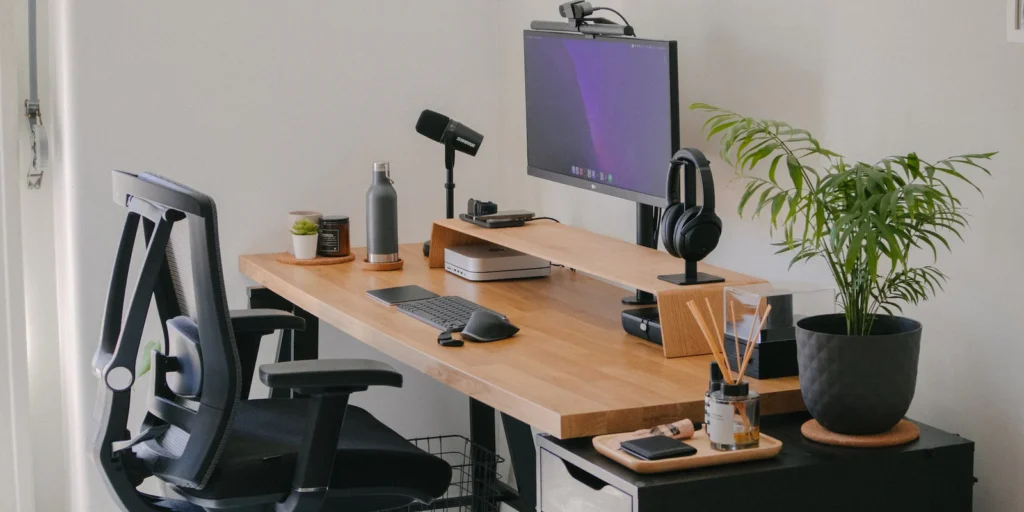
Working from home has become the new normal for many, but with it comes a not so welcome guest: neck and back pain. If your home office is actually your dining table, sofa, or bed, chances are your body is quietly suffering.
The good news? With a few simple adjustments, you can transform any space into a more ergonomic, spine friendly workstation. And no you don’t need fancy equipment to do it.
Let’s walk through how to set up your home office in a way your back, neck, and overall posture will love you for.
1. Start With the Chair- Your Throne Matters
Your chair is the unsung hero of your workday. Ideally, it should:
- Support your lower back’s natural curve
- Let your feet rest flat on the floor
- Allow knees to be level with or slightly below your hips
Quick Fixes:
- If your chair lacks lumbar support, roll up a towel and place it behind your lower back.
- Use a cushion to elevate yourself if your feet don’t touch the floor.
Avoid perching on high stools, soft sofas, or beds for long stretches. They’re comfort traps with painful consequences.
2. Sort Out Your Screen Height
A major culprit of neck pain? Looking down at your laptop all day.
Your screen should be at eye level, so you’re not tilting your head forward or down. This keeps your head aligned over your shoulders reducing strain on your neck and upper back.
Quick Fixes:
- Stack books or a shoebox under your laptop to raise it.
- Use an external keyboard and mouse so your hands stay at desk level while the screen is elevate
3. Keyboard and Mouse Positioning
Your arms should rest comfortably by your sides, elbows at roughly a 90 degree angle.
- Keep your wrists straight and relaxed
- Avoid overreaching for your mouse
- Position the keyboard so it’s directly in front of you, not off to the side
Quick Fix: Place a small towel under your wrists for support if needed.
4. Lighting and Glare- Save Your Eyes and Posture
Squinting at a dim screen or avoiding glare can lead to awkward head positions and, eventually, neck strain.
- Use natural light where possible
- Avoid having windows or bright lights directly behind your screen
- Adjust screen brightness and font size for easy reading
Bonus: Good lighting can actually improve your mood and productivity.
5. Take Movement Breaks- Your Body Loves Variety
No matter how perfect your setup is, staying in one position for too long is harmful. Set a timer or reminder to move every 30-60 minutes.
- Stand up and stretch
- Do a few squats, shoulder rolls, or walk around
- Try a standing desk setup part of the day (use the kitchen counter if needed!)
Motion is lotion for your joints, muscles, and brain.
6. Listen to Your Body
Pain, stiffness, or tension are your body’s way of saying something’s off.
Don’t ignore:
- Persistent neck tightness
- Lower back stiffness
- Tingling or numbness in arms or legs
- Headaches that worsen with screen time
If symptoms don’t improve with setup changes and breaks, consider seeing a physiotherapist. They can assess your posture, work habits, and give targeted advice or treatment.
7. Add Simple Comfort Boosters
- A footrest (or a stack of books) to support dangling feet
- A headset for long calls (stop cradling your phone with your shoulder!)
- A small cushion behind your upper back to keep posture upright
- Plants or personal touches to make your space more enjoyable
A happier workspace can reduce stress and we all know stress adds tension to the body.
Final Thoughts
You don’t need a Pinterest perfect home office to avoid neck and back pain. What you need is a thoughtful setup that works with your body, not against it.
Small changes like raising your screen, sitting with support, and moving regularly can have a big impact. It’s about creating a space that’s not just productive but physically sustainable.
Your back and neck will absolutely thank you. So will your energy levels, focus, and mood.
Now go ahead take five minutes to make one positive change to your workspace. Your future self will be grateful!
